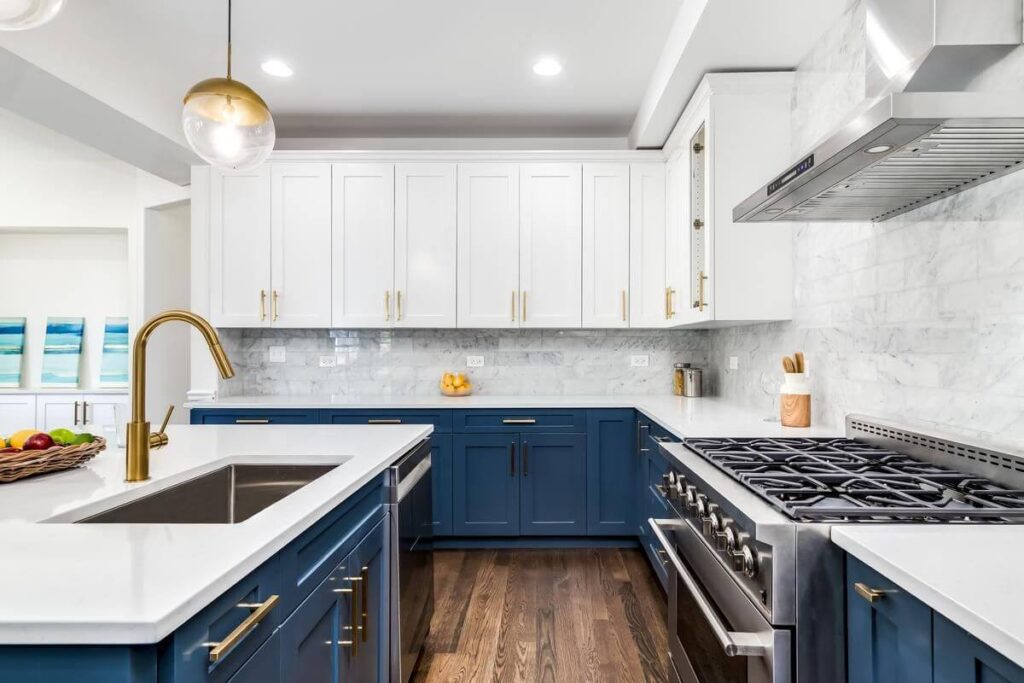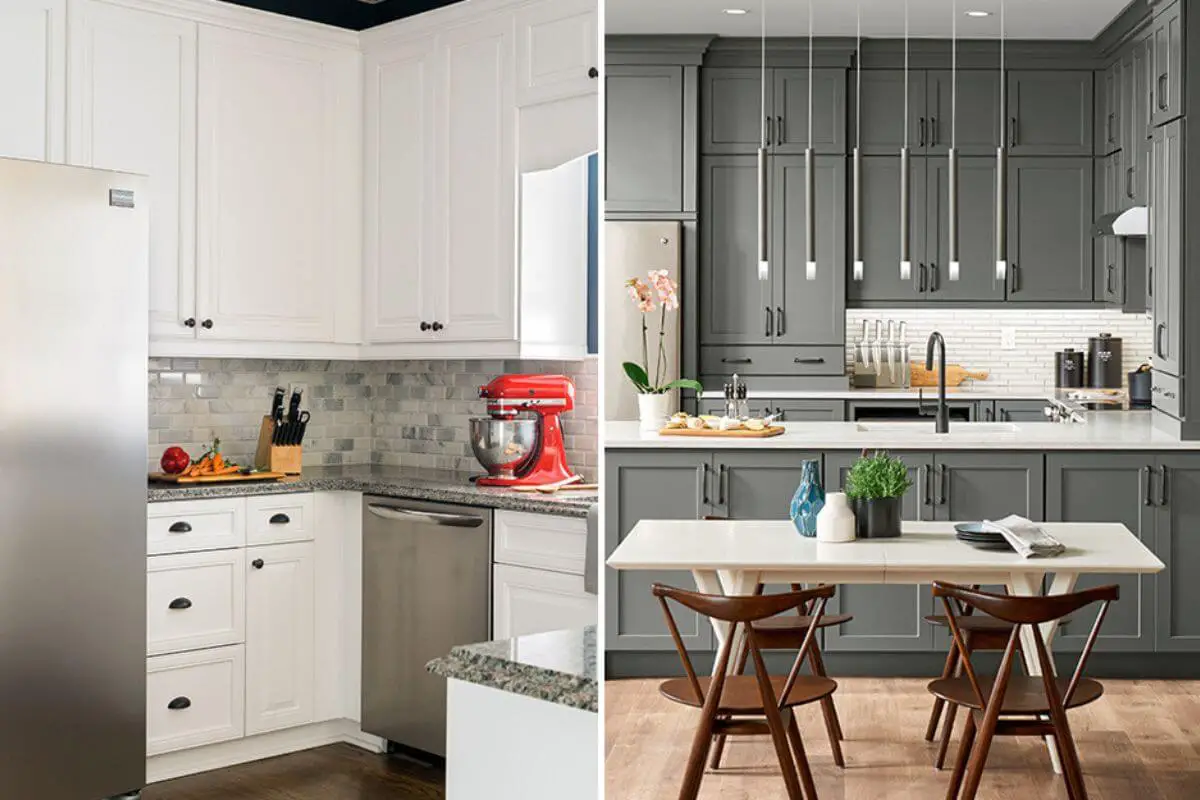Introduction
When it comes to remodeling your kitchen, one of the most critical decisions you’ll make is choosing the right cabinets. The battle between custom and stock kitchen cabinets has been a long-standing debate in the world of interior design. This article will help you understand the pros and cons of each type, enabling you to make an informed decision that suits your budget, style, and functionality needs.
The Basics of Kitchen Cabinets
Function and Purpose:
Kitchen cabinets are essential storage units found in kitchens. They are designed to store cookware, dishes, utensils, food items, and various kitchen essentials. Cabinets help keep the kitchen organized and clutter-free.

Materials:
Kitchen cabinets can be constructed from a variety of materials, with wood being one of the most common choices. Other materials include particleboard, plywood, MDF (Medium-Density Fiberboard), and metal. The choice of material can impact the durability, appearance, and cost of the cabinets.
Styles:
Kitchen cabinets come in various styles to suit different aesthetics and design preferences. Some common styles include traditional, modern, shaker, and flat-panel. The style of cabinets can significantly influence the overall look of the kitchen.
Cabinet Components:
A typical kitchen cabinet consists of several components, including:
- Cabinet Box: The main structure of the cabinet, which includes the sides, top, and bottom.
- Doors: The front panels that conceal the contents of the cabinet.
- Drawer Fronts: Panels on the front of drawers.
- Hinges: Used to attach doors to the cabinet box.
- Drawer Slides: Mechanisms that allow drawers to open and close smoothly.
- Handles or Knobs: Hardware used to open doors and drawers.
- Shelves: Interior storage surfaces within the cabinet.
- Cabinet Legs or Feet: Provide support and clearance from the floor.
Finishes and Colors:
Cabinets can be finished in various ways, such as staining, painting, or using natural wood finishes. The choice of finish and color can greatly affect the kitchen’s overall design.
Configuration:
Kitchen cabinets come in different configurations to accommodate various storage needs. Common configurations include base cabinets (for countertops), wall cabinets (mounted on the wall), tall cabinets (for pantry storage), and corner cabinets (utilizing space in corners).
Customization:
Many kitchen cabinets can be customized to fit the specific needs of the homeowner. This includes adjusting sizes, adding features like pull-out trays, lazy Susans, or spice racks, and choosing unique hardware.
Installation:
Proper installation is crucial for the functionality and longevity of kitchen cabinets. It’s often best left to professionals, as it requires careful measurements and secure mounting.
Maintenance:
Regular cleaning and maintenance are essential to keep kitchen cabinets in good condition. Wipe down surfaces, tighten hardware, and address any issues promptly to extend their lifespan.
Cost:
The cost of kitchen cabinets can vary widely based on factors such as material, quality, customization, and size. It’s important to establish a budget and consider the long-term value of the investment when choosing kitchen cabinets.
Understanding these basics will help you make informed decisions when selecting and maintaining kitchen cabinets for your home.
What are Stock Cabinets?
Stock cabinets, also known as ready-to-assemble (RTA) cabinets, are pre-made kitchen or bathroom cabinets that are mass-produced and readily available for purchase off the shelf in standard sizes and designs. These cabinets are typically manufactured in large quantities and are sold by various home improvement stores, cabinet retailers, and online suppliers.
What are Custom Cabinets?
Custom cabinets, on the other hand, are uniquely tailored to your kitchen’s specifications. They are crafted from scratch, allowing for a higher degree of personalization.
Pros and Cons
Now, let’s explore the advantages and disadvantages of both custom and stock kitchen cabinets.
Custom Kitchen Cabinets:
Pros:
Tailored Design:
Custom cabinets are built to fit your kitchen’s exact dimensions, allowing for a personalized and unique design. You have full control over the style, materials, finishes, and features, ensuring your cabinets perfectly match your vision.
High-Quality Materials:
Custom cabinets often use high-quality materials, such as solid wood, plywood, and premium finishes, which can result in greater durability and a longer lifespan.
Maximized Space:
Custom cabinets can be optimized for your kitchen’s layout, maximizing storage space and functionality. You can incorporate specialized storage solutions, such as pull-out shelves and built-in organizers.
Aesthetically Pleasing:
Since you have full creative control, custom cabinets can be designed to seamlessly blend with your kitchen’s aesthetics, enhancing the overall look of the space.
Long-Term Investment:
While more expensive upfront, custom cabinets can add significant value to your home and are often considered a long-term investment.
Cons:
Higher Cost:
Custom cabinets are considerably more expensive than stock cabinets due to the personalized design, high-quality materials, and craftsmanship involved.
Extended Lead Time:
Building custom cabinets takes time, so the lead time from design to installation can be longer, potentially delaying your kitchen renovation project.
Professional Installation:
Custom cabinets may require professional installation, adding to the overall cost.
Stock Kitchen Cabinets:
Pros:
Affordability:
Stock cabinets are generally more budget-friendly, making them an excellent choice for cost-conscious homeowners.
Quick Availability:
Since stock cabinets are pre-made, they are readily available for immediate or short-term delivery, which can be advantageous for projects with tight timelines.
Ease of DIY Installation:
Many stock cabinets are designed for easy assembly and installation, making them suitable for do-it-yourself (DIY) homeowners.
Standard Sizes:
Stock cabinets come in standard sizes, which can be suitable for most kitchen layouts, especially in homes with common configurations.
Cons:
Limited Customization:
Stock cabinets offer limited style options and sizes. While there are choices available, you may have to compromise on your ideal design and layout.
Lower Quality Materials:
Stock cabinets often use more basic materials like particleboard or MDF, which may not be as durable as the materials used in custom cabinets.
Standard Design:
The designs of stock cabinets may not align perfectly with your kitchen’s unique features and aesthetics, resulting in a less personalized look.
Reduced Functionality:
Stock cabinets may lack some of the specialized storage solutions and features that can be incorporated into custom cabinets, potentially limiting their functionality.
Which One Is Right for You?
The choice between custom and stock kitchen cabinets ultimately depends on your specific needs, budget, and preferences. Here are a few considerations to help you decide:
- Budget: If you have a limited budget, stock cabinets may be the better choice.
- Timeline: If you need your kitchen completed quickly, stock cabinets are the way to go.
- Design and Personalization: If you want a unique, tailored kitchen, custom cabinets are the answer.
- Long-Term Investment: For homeowners looking for long-lasting quality and a high-end finish, custom cabinets are worth the investment.
Conclusion
In the great debate of kitchen cabinets, the choice between custom and stock cabinets boils down to personal preferences and practical needs. Your kitchen is the heart of your home, and your cabinets play a vital role in its functionality and aesthetics. Whether you choose the affordability and quick availability of stock cabinets or the personalized touch and quality of custom cabinets, make a choice that aligns with your vision for your dream kitchen.
FAQs
How long does it take to install custom cabinets?
Custom cabinet installation can take several weeks to a few months, depending on the complexity of your design.
Are stock cabinets of lower quality than custom cabinets?
Stock cabinets are often made with more basic materials compared to custom cabinets, so they may be of slightly lower quality.
Can I combine custom and stock cabinets in my kitchen?
Yes, many homeowners choose a combination of both to balance budget and customization.
Do custom cabinets add value to a home?
yes, custom cabinets can increase the resale value of your home, as they are often seen as a luxury feature.
What is the average cost difference between custom and stock cabinets?
Custom cabinets can be two to three times more expensive than stock cabinets, but the exact cost varies based on the materials and design choices.



